Do you have a question about the Lochinvar FTxl 725 and is the answer not in the manual?
Imminent hazard, death or serious injury.
Potential hazard, death or serious injury.
Potential hazard, minor or moderate injury.
Read all instructions, including manuals, before installing.
Warnings for operation, maintenance, and potential hazards.
Emergency steps for gas leaks.
Water flow around tubes for heat transfer and corrosion protection.
Mixes air and gas for combustion.
Controls gas flow based on blower pressure.
Boiler performance ratings confirmed by AHRI.
Boiler dimensions, connections, and technical data.
Adherence to local, state, and national codes.
Specific requirements for confined spaces.
Precautions for installing appliances in garages.
Avoiding corrosive air sources for combustion.
Table listing substances that can damage the boiler.
Procedures for safely removing a boiler from a common vent.
Guidelines for air supply to the equipment room.
Steps to safely remove the boiler from its packaging.
Procedures for converting to LP gas.
Sidewall and vertical vent configurations.
Connecting vent and air pipes.
Canadian certification and installation standards.
Combustion air and vent piping size requirements.
Criteria for connecting multiple FTXL boilers to a common vent.
Approved materials and installation for PVC/CPVC venting.
Approved materials and installation for polypropylene venting.
Approved materials and installation for stainless steel venting.
Guidelines for terminating vent and air pipes through a sidewall.
Factors for choosing the vent/air termination location.
Procedures for creating openings in walls for vent/air.
Terminating multiple vent/air connections.
Using a concentric vent kit for sidewall termination.
Guidelines for terminating vent and air pipes vertically through a roof.
Factors for choosing the vent/air termination location.
Procedures for creating openings in roofs for vent/air.
Terminating multiple vent/air connections vertically.
Using a concentric vent kit for vertical termination.
Using an existing vent system as a chase for vent and air.
Closed loop system design and pressure requirements.
Using glycol for freeze protection.
Basic steps for system piping installation.
Installing safety and monitoring devices.
Components for piping near the boiler.
Selecting appropriate circulators.
Setup for variable speed pumps.
Controlling multiple temperature loops.
Table for sizing based on temperature rise.
Piping for multiple boilers in a primary/secondary system.
Piping for a single boiler with multiple temperature loops.
Piping for a single boiler in a primary/secondary system.
Piping for multiple boilers with multiple temperature loops.
Piping for multiple boilers in a primary/secondary system.
Piping for DHW as a zone.
Installing gas supply lines to the boiler.
Specific requirements for natural gas.
Specific requirements for propane gas.
Verifying gas supply pressure and integrity.
Required gas pressures for operation.
Procedures and warnings for gas valve replacement.
Connecting the 120 VAC power supply.
Routing and connecting low voltage wires.
Connecting room thermostats and zone controls.
Installing sensor for outdoor reset operation.
Connecting DHW controls.
Connecting the tank sensor for DHW control.
Connecting multiple boilers in a cascade.
Managing condensate from the appliance.
Ensuring proper water quality and filling the system.
Using glycol for freeze protection.
Preventing oxygen-related corrosion.
Precautions for boiler water chemistry.
Removing air from the system.
Verifying gas connections for leaks.
Verifying thermostat wiring.
Verifying burner operation and combustion.
Final checks before boiler operation.
Configuring heating operation.
Setting the domestic hot water temperature.
Setting up boilers for cascade operation.
Overview of boiler operation.
Basic process of boiler functioning.
Prioritizing domestic hot water calls.
Managing pump operation.
Adjusting set points based on outdoor temperature.
Increasing set point based on continuous demand.
Programming reduced set points for savings.
Boiler's built-in freeze protection features.
Over-temperature and flue temperature limits.
Controlling boiler temperature.
Automatic and manual reset high limits.
Testing high limit controls.
Operating order for boilers in a cascade.
Description of the control panel interface.
Information displayed on the control panel.
Tables for maintenance tasks.
Steps for resolving reported issues.
Checking the area around the boiler.
Cleaning the condensate trap.
Verifying all piping is leak-free.
Inspecting vent and air piping.
Inspecting and testing the relief valve.
Inspecting and cleaning electrodes.
Inspecting the burner flame.
Procedure for cleaning the heat exchanger.
Electrical wiring schematic for the boiler.
Control logic diagram for boiler operation.
Imminent hazard, death or serious injury.
Potential hazard, death or serious injury.
Potential hazard, minor or moderate injury.
Read all instructions, including manuals, before installing.
Warnings for operation, maintenance, and potential hazards.
Emergency steps for gas leaks.
Water flow around tubes for heat transfer and corrosion protection.
Mixes air and gas for combustion.
Controls gas flow based on blower pressure.
Boiler performance ratings confirmed by AHRI.
Boiler dimensions, connections, and technical data.
Adherence to local, state, and national codes.
Specific requirements for confined spaces.
Precautions for installing appliances in garages.
Avoiding corrosive air sources for combustion.
Table listing substances that can damage the boiler.
Procedures for safely removing a boiler from a common vent.
Guidelines for air supply to the equipment room.
Steps to safely remove the boiler from its packaging.
Procedures for converting to LP gas.
Sidewall and vertical vent configurations.
Connecting vent and air pipes.
Canadian certification and installation standards.
Combustion air and vent piping size requirements.
Criteria for connecting multiple FTXL boilers to a common vent.
Approved materials and installation for PVC/CPVC venting.
Approved materials and installation for polypropylene venting.
Approved materials and installation for stainless steel venting.
Guidelines for terminating vent and air pipes through a sidewall.
Factors for choosing the vent/air termination location.
Procedures for creating openings in walls for vent/air.
Terminating multiple vent/air connections.
Using a concentric vent kit for sidewall termination.
Guidelines for terminating vent and air pipes vertically through a roof.
Factors for choosing the vent/air termination location.
Procedures for creating openings in roofs for vent/air.
Terminating multiple vent/air connections vertically.
Using a concentric vent kit for vertical termination.
Using an existing vent system as a chase for vent and air.
Closed loop system design and pressure requirements.
Using glycol for freeze protection.
Basic steps for system piping installation.
Installing safety and monitoring devices.
Components for piping near the boiler.
Selecting appropriate circulators.
Setup for variable speed pumps.
Controlling multiple temperature loops.
Table for sizing based on temperature rise.
Piping for multiple boilers in a primary/secondary system.
Piping for a single boiler with multiple temperature loops.
Piping for a single boiler in a primary/secondary system.
Piping for multiple boilers with multiple temperature loops.
Piping for multiple boilers in a primary/secondary system.
Piping for DHW as a zone.
Installing gas supply lines to the boiler.
Specific requirements for natural gas.
Specific requirements for propane gas.
Verifying gas supply pressure and integrity.
Required gas pressures for operation.
Procedures and warnings for gas valve replacement.
Connecting the 120 VAC power supply.
Routing and connecting low voltage wires.
Connecting room thermostats and zone controls.
Installing sensor for outdoor reset operation.
Connecting DHW controls.
Connecting the tank sensor for DHW control.
Connecting multiple boilers in a cascade.
Managing condensate from the appliance.
Ensuring proper water quality and filling the system.
Using glycol for freeze protection.
Preventing oxygen-related corrosion.
Precautions for boiler water chemistry.
Removing air from the system.
Verifying gas connections for leaks.
Verifying thermostat wiring.
Verifying burner operation and combustion.
Final checks before boiler operation.
Configuring heating operation.
Setting the domestic hot water temperature.
Setting up boilers for cascade operation.
Overview of boiler operation.
Basic process of boiler functioning.
Prioritizing domestic hot water calls.
Managing pump operation.
Adjusting set points based on outdoor temperature.
Increasing set point based on continuous demand.
Programming reduced set points for savings.
Boiler's built-in freeze protection features.
Over-temperature and flue temperature limits.
Controlling boiler temperature.
Automatic and manual reset high limits.
Testing high limit controls.
Operating order for boilers in a cascade.
Description of the control panel interface.
Information displayed on the control panel.
Tables for maintenance tasks.
Steps for resolving reported issues.
Checking the area around the boiler.
Cleaning the condensate trap.
Verifying all piping is leak-free.
Inspecting vent and air piping.
Inspecting and testing the relief valve.
Inspecting and cleaning electrodes.
Inspecting the burner flame.
Procedure for cleaning the heat exchanger.
Electrical wiring schematic for the boiler.
Control logic diagram for boiler operation.
| Model | FTxl 725 |
|---|---|
| Input BTU/hr | 725, 000 |
| Fuel Type | Natural Gas or Propane |
| Water Connection Size | 2" NPT |
| Modulation Ratio | 10:1 |
| Width | 30 in. |
| Depth | 30 in. |
| Electrical Supply | 120V, 60Hz, 1Ph |
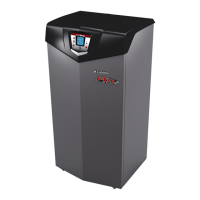
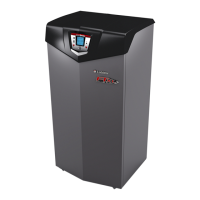
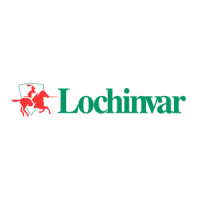


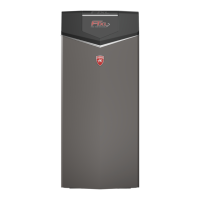


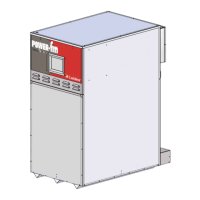
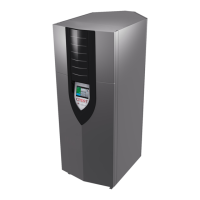
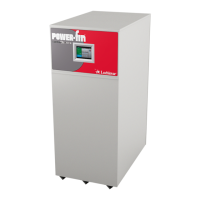
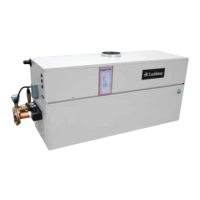
